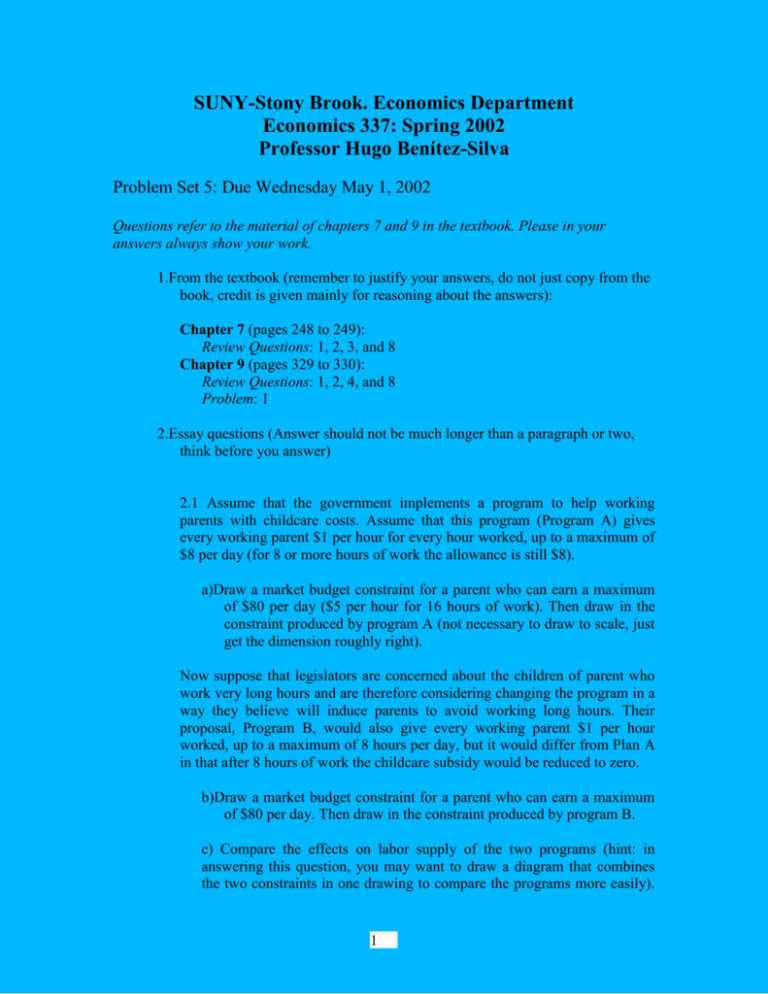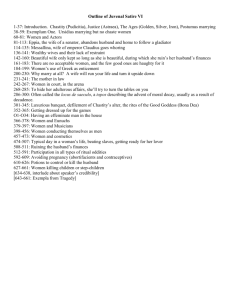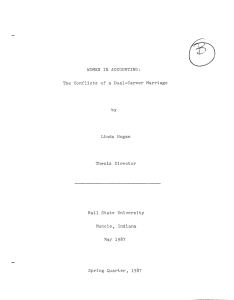Problem Set 5
advertisement

SUNY-Stony Brook. Economics Department Economics 337: Spring 2002 Professor Hugo Benítez-Silva Problem Set 5: Due Wednesday May 1, 2002 Questions refer to the material of chapters 7 and 9 in the textbook. Please in your answers always show your work. 1.From the textbook (remember to justify your answers, do not just copy from the book, credit is given mainly for reasoning about the answers): Chapter 7 (pages 248 to 249): Review Questions: 1, 2, 3, and 8 Chapter 9 (pages 329 to 330): Review Questions: 1, 2, 4, and 8 Problem: 1 2.Essay questions (Answer should not be much longer than a paragraph or two, think before you answer) 2.1 Assume that the government implements a program to help working parents with childcare costs. Assume that this program (Program A) gives every working parent $1 per hour for every hour worked, up to a maximum of $8 per day (for 8 or more hours of work the allowance is still $8). a)Draw a market budget constraint for a parent who can earn a maximum of $80 per day ($5 per hour for 16 hours of work). Then draw in the constraint produced by program A (not necessary to draw to scale, just get the dimension roughly right). Now suppose that legislators are concerned about the children of parent who work very long hours and are therefore considering changing the program in a way they believe will induce parents to avoid working long hours. Their proposal, Program B, would also give every working parent $1 per hour worked, up to a maximum of 8 hours per day, but it would differ from Plan A in that after 8 hours of work the childcare subsidy would be reduced to zero. b)Draw a market budget constraint for a parent who can earn a maximum of $80 per day. Then draw in the constraint produced by program B. c) Compare the effects on labor supply of the two programs (hint: in answering this question, you may want to draw a diagram that combines the two constraints in one drawing to compare the programs more easily). 1 In particular, analyze whether Program B is superior to Program A in terms of inducing parents who are now working more than 8 hours a day to reduce their hours of work. 2.2. A few years ago, the New England Medical College inadvertently accepted more applicants than it could accommodate in its first year class. Not wanting to arbitrarily delay the entrance date of its admitees, it offered them one year of free tuition if they would delay their medical studies by one year. Discuss the factors entering into the student's assessment of whether he or she should take this offer. 3. Group Question We have studied the Human Capital theory in Labor Economics. The core of this theory tries to explain why some individuals choose to invest more in their education or training than others. Using that theory try to explain a phenomenon that is occurring in some countries around the world: overeducation. This basically means that compared to what we would have expected too many people in some countries are attending and finishing college. A lot of them will end up doing jobs very different from what they studied, and applying only a very small fraction of the concepts they work so hard to acquire. How is this possible? Are these individuals not rational? Is the theory wrong? Find some information on this issue and make sense of it in light of the theories we have explored. 4. Choose the one alternative that best completes the statement or answers the question. There are 6 statements or questions. It is not enough to circle one answer. You have to give a brief but appropriate explanation. A) If a family's budget constraint shifts because of an increase in non-labor income, then a member of the family who works outside of the home will a) choose to decrease his or her hours of work b) choose to increase his or her hours of work c) not change his or her hours of work d) either increase or decrease his or her hours of work, depending on the size of the substitution effect e) not enough information is provided B) If the only working member of a household receives an increase in her wage rate, then a)She will choose to increase her hours of wok b)She will choose to decrease her hours of work 2 c)She will not change her hours of work d)She could increase, decrease, or maintain her current hours of work C) If the husband and wife are substitutes in the production of household goods, then a decrease in the husband's labor supply will tend to a)Decrease the wife's labor supply. b)Increase the wife's labor supply. c)Cause no change in the wife's labor supply. d)Either increase or decrease the wife's labor supply D) Present oriented people discount future earnings __________ forward looking people a)at the same rate as b)at a higher rate than. c)at a lower rate than. d)at a higher or lower rate than. E) Nina (age 19) would be more likely to obtain a college education if a)her discount rate was lower b)the supply of others with a college education was greater c)she expected to retire at a younger age d)she was older F) Employees tend to obtain on the job training a)at an increasing rate during their careers b)all at once, early in their careers c)only at the end of their careers d)over a number of years, at a declining rate over their careers 3








